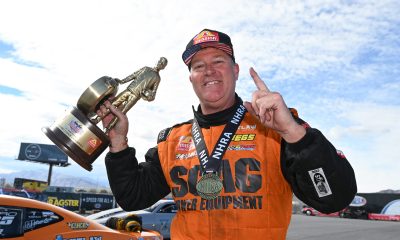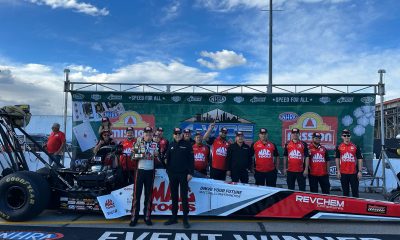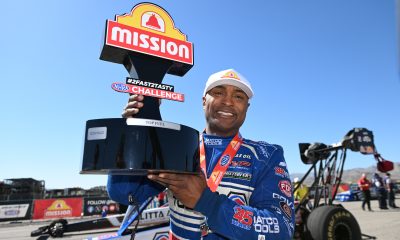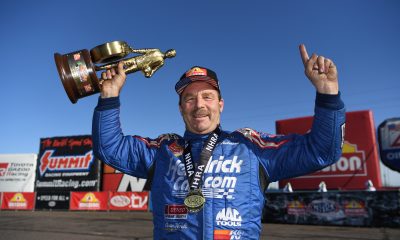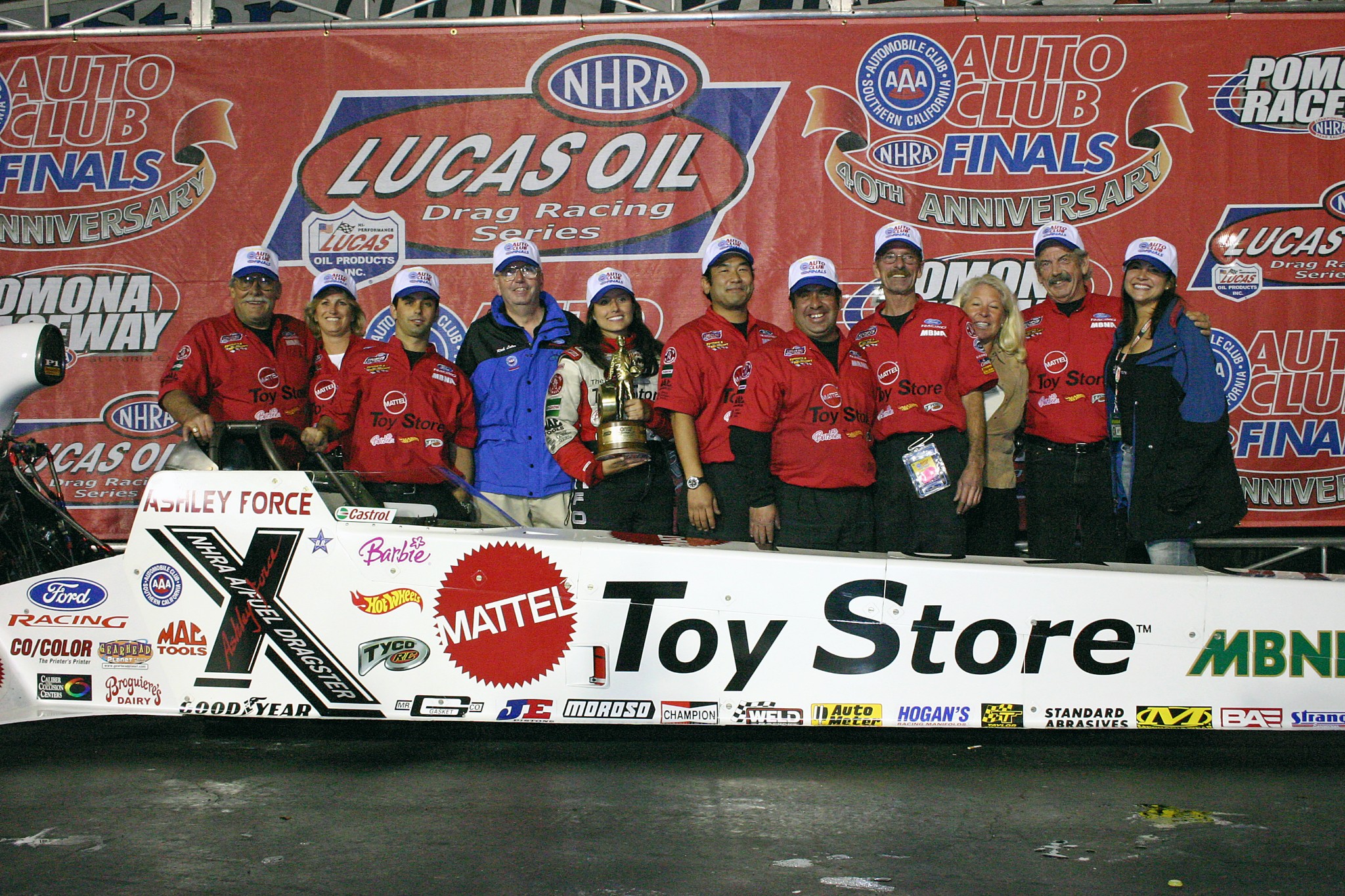
(Photo: John Force Racing)
In this edition of first-seasons where The Podium Finish catches up with a motorsports driver past and present, we catch up with former NHRA driver Ashley Force Hood. During the interview, Force discusses what it was like making her debut in Top Alcohol Dragster, what she was racing before then, how she was able to get her first opportunity behind the wheel, setting expectations for herself, and memories of winning her first national race at the U.S. Nationals among many other topics in this edition of first-seasons.
Briar Starr: You made your first Top Alcohol Dragster start at the age of 21, driving for Jerry Darien and Ken Meadows during the 2004 season after making a license run in the 2003 season. Briefly discuss what it was like making your debut at that age and how you got connected with Darien and Meadows which gave you an opportunity to race in Top Alcohol Dragster? Was it a dream come true for you at the time to race in NHRA?
Ashley Force: I grew up in drag racing because of my dad (John Force), so I was very familiar with it. Before A-Fuel, I did a few years in SuperComp. I never did junior drag racing because I was waiting to see if they were going to have a junior Funny Car, but I got to the age, where I could get to a SuperComp. Looking back, I’m bummed I didn’t get to do that, but I do get to do it today with my kids.
When I started in SuperComp, I was going to college. I knew I wanted to go to college no matter what, there was never a question for me. That was the path I knew I wanted to be on. I would make my classes on Monday nights, Tuesdays, Wednesdays, and Thursdays morning class. Shortly thereafter, I could fly out to whatever race I was headed to and do the race weekend. The schedule worked out really during that time of my life, where I could do the schooling, and also on the weekends to go race.
After two years in SuperComp, I knew I wanted to move up to A-Fuel, and at the time, it was all the up-and-coming rookie drivers. A lot of them went through Darien and Meadows. That was the team to be on. They were a good spot for newer drivers. My dad is a Funny Car guy through and through, so for him to start an A-Fuel team, it was just not where our company was. Darien and Meadows had a great way of managing their team.
If I can do it all over again, I would. We had a great team and felt comfortable with them. They welcomed me with wide open arms and it was a great experience for me. I was mashed with the right people.
Starr: At age 21, did you feel like you were ready to race on a full-time schedule in the NHRA, especially going full-time right away? Looking back, do you wish you had a part-time schedule in ‘03 before full-time in ‘04, or was going full-time right away the best decision?
Force: For me, the full-time schedule was the way to go. I wasn’t trying to balance a full-time job at home, I was done with school, and I graduated a semester early because I took summer classes. I graduated in January and the racing season started in February. We knew we wanted to be done with school and then go racing. So, that was how we did it.
I just wouldn’t have wanted to do it any other way. To do this, you’re going to commit to the travel and the racing life. I also had sponsors and they wanted to see their car as much as possible. If you’re able to do that, that’s the way to do it. I think it’s because growing up with my dad, he never was a racecar driver who also had a job at home. We never had that. In our whole life, we always raced.
It was fun and a whirlwind when we kicked the racing deal off. You’re living on the road and traveling a lot. We raced in Kansas and I remember one time, we did a divisional race and drove many hours to the Topeka track. On the way there, we stopped at the Wizard of Oz museum. It was just the funniest thing because of all these crew people and having the trailer parked out front. That’s something I vividly remember. It was just a good time.
Starr: Obviously, having the last name Force, there can be a lot of pressure to perform. Did you feel any of that pressure when you started racing in the alcohol classes?
Force: I felt a little pressure, but the pressure I had was just put on by myself. I always felt a little disadvantaged. A lot of drivers racing on these cars had a background on them and I didn’t. I took an auto shop and welding, but I will be the first to admit, I am not a grease type of person and get underneath the car.
For the amount of media I had to do, I couldn’t have been a crew member on the car. That part was kind of tricky because I didn’t have those skills, but then on the flip side, sometimes you’re not overthinking it when you don’t know the ins and outs of a car. I think that helped somewhat to a degree.
The pressure was more of my own. The sponsors were so great and were supportive. They were just happy that I was able to meet their customers. I will say, there was a lot of media attention because that was tricky for me during my Funny Car years compared to A-Fuel. I’m kind of a shy person and that was the toughest for me. I remember being very overwhelmed and a little bit nervous in that situation. I did have to work on that a bit, but that was more so in my Funny Car years than A-Fuel.
Starr: Your first start came at the Winternationals at Pomona. You made your first pass with a 5.510 at 243.02 mph in Q1 and eventually qualified fifth. You won your first career round win before losing in the second round. What were the weeks like leading up to your initial debut? Were you anxious, or nervous or were you already to go especially after making a couple of runs in qualifying?
Force: We came from testing I think Phoenix or Las Vegas and that’s usually a couple of weeks ahead of time. By that point, I felt very comfortable in the car, and I knew what I needed to do. Being at Pomona, it was my home track because I grew up there. I don’t remember having this huge feeling of nervousness because I had already gone through the procedures.
Doing interviews at the racetrack like the top end or in the pits was a little new to me, so those kinds of things were a little bit different for me. One thing that does stick out to me is when I went into the sand pit during the first round In Pomona, there’s a short shutdown area. I won my first round and the light came on the wall, and I was so excited to win that there was a delayed response in shutting down the car.
There’s an interview out there somewhere where I’m crying because I was very upset going in the sand, but also excited because we won. I’ve seen the interview before and all my team just comes over to hug me like it’s okay, we’ll get it back together.
Starr: After Pomona, you had some respectable finishes with a semi-final appearance in Gainesville and first runner-up at Atlanta. As the season progressed, did you ever think you were getting comfortable with the car, or was there still a learning curve as you went?
Force: There’s always a learning curve, but I had the baseline locked down. I had a really good team and a good car. The setup was good, it was just basically mine to mess up. If I did my job from A to B, then it worked out perfectly. We had one of the fastest cars at the time. In the A-Fuel years, it was just getting the car down the track, and don’t make mistakes.
Starr: In the summertime of ‘04, you won your first NHRA regional race at Rusk, Texas Cherokee Speedway, and then went on to win your first national victory at the famous U.S. Nationals at Indianapolis in late August. What do those two victories still mean to you and what are some favorite moments that you can recall when winning those races?
Force: I remember being in the winner circle at the end of the day and I can’t recall if it was raining or not, as so many fans left and it was just our team. It was nice since I could just have a special moment with my team and not be too overwhelmed. The U.S. Nationals was a completely different win with how big the race is.
I remember that well because growing up, one of my best buddies was Gary Densham’s son, Steven Densham. He and I grew up together. At the time, Gary was driving for us, and he won on the same day I did. That was special for me to get to share that with him. Here’s this person who’s been in my life since I was born and he is now on our team. What a big moment for him to get a win with our team and I got the win. There was a big double-winner circle and what a day it was.
After celebrating the victory, I was so exhausted at the end of the day after doing so many interviews, but very exciting time.
Starr: After winning Indianapolis, you scored a win at Dallas, another runner-up at Reading, and eventually scored the win at the season-ending race at Pomona while your dad won in Funny Car that same day. What do you remember about winning Pomona and John winning in Funny Car?
Force: The finals at Pomona is always a special weekend because everyone is exhausted after a whole year of racing. The race is usually in cool conditions and the final rounds are happening after the sun goes down. Of course, all of your family friends, and teachers are out there.
Being at your home track, it’s so special if you can win there since everyone is there. I do remember at that time, we weren’t doing our reality show just yet, which started in 2006. Our producer came on the road with us in 2004 and had to make a reel tape. He and a couple of film people were there. In a perfect world, Dad and I would win on the same day that the film crew was there, and of course, that happened. That was kind of neat to capture all of that with the cameras.
It was the biggest winner circle in front of the tower with my dad’s team winning as well. At least over 100 people were in the photo along with my niece Autumn who was just three months old at the time and she was in the winner photo too. It was just a magical time.
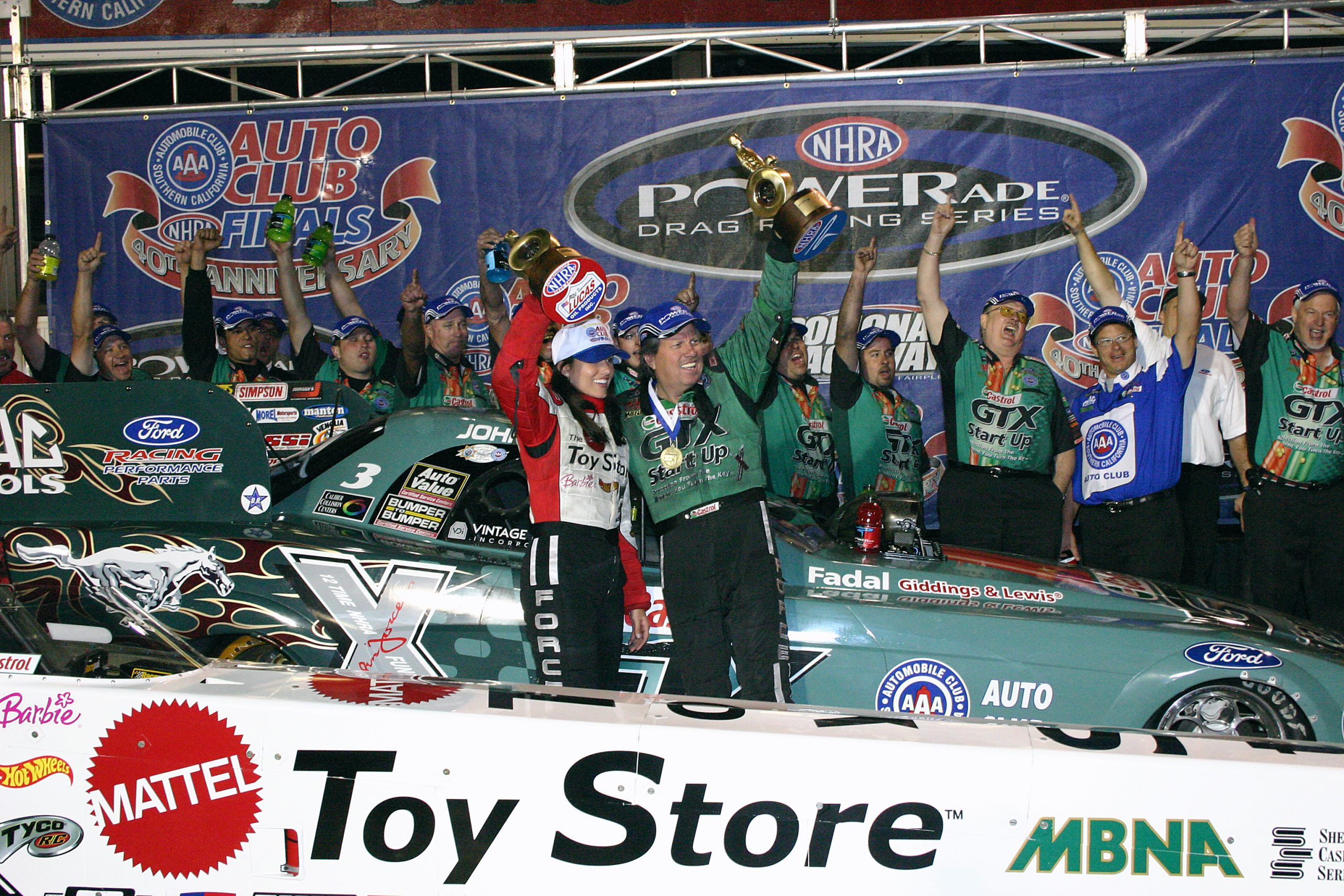
Ashley and John Force in Victory Lane at Pomona. (Photo: John Force Racing)
Starr: During your rookie season as a driver, you scored three wins and won Lucas Series races at Englishtown and Belle Rose, Louisiana ultimately claiming the Division 4 championship and finishing fourth in the national standings. As you reflect back on your rookie year, were you satisfied with what you were able to accomplish as a rookie or do you think you could’ve done more?
Force: Driving wise, I was happy with what I did in my first year of A-Fuel. I felt like I needed to be comfortable with fans and in the spotlight, that was something I had to work on. Driving in the A-Fuel Dragster, they didn’t cause a lot of trouble because they drove so smoothly. Even having to peddle it, as long as you let the tire settle, and don’t make any mistakes you can regroup. I don’t remember those things in A-Fuel, but in Funny Car, there was a big learning curve in how to peddle it.
Another thing that people don’t think about is you see what is happening next to you in the other lane. You shouldn’t be looking at the other car and that is a skill to learn, no matter what is happening. It’s a real mind thing not to let that affect you too. You have to pay attention to your lane. In A-Fuel, I don’t remember too many peddle fest.
Starr: In your Top Alcohol career, you had five career victories with five No. 1 qualifiers. Meanwhile, in your nitro career, four career victories and 15 No. 1 qualifiers. What would you say is your favorite trophy in your alcohol career and favorite trophy in your nitro career, the ones that mean the most to you?
Force: In my A-Fuel years, it was so special to win with my dad. As a daughter cheering on her dad, winning at Pomona on the same day with him was so special at our home track, and all of our family being there. In Funny Car, I won twice at Indy. I would say winning Indy is my favorite in the Funny Car class.
Starr: Some racers have a memorabilia collection and some don’t. Are you a driver that collects your merchandise and if so, what in your collection reminds you about your rookie season(s)?
Force: I have a big quilt blanket with all of my shirts on it. You can send it to a company that makes a quilt out of it, which I thought was neat. I had gotten the quilt when I was having my son at the time. I also have race trophies and helmets. In my office at work, I have a bin with old fire boots and tons of devices. I do have diecast, which I saved for my kids to have someday.
Starr: What is one memory or learning lesson you learned in your rookie season that helped you later on in your career?
Force: We were at a race and something happened when they were turning over the motor, and I don’t know because that’s all behind the driver. We’re at the starting line and I’m waiting for Jerry to come over and give me the signal. Well, Jerry (my team owner) comes in and he reaches in with blood dripping off his hand. Something happened when he cut his hand or arm during the startup procedure.
It was just interesting because the car was running and we had to do the same routine no matter what. That was a good lesson for me not to panic and just keep doing the same procedure that you’re used to.
Starr: Wrapping this interview up – It’s hard to believe your first start came 19 years ago. However, if time travel was available, what would a 41-year-old Ashley Force Hood tell a 21-year-old Ashley Force Hood? Is there anything you would do differently?
Force: Now that I do video production for our race team, I’m kind of on the other side of it getting stories from the drivers, I get to see it from a different angle. When I was younger, the whole publicity side of the fans was a struggle for me.
Now to see it from the other side, I remember at the time being in my head because the fans would be at the ropes yelling and I would feel like they were upset with me since I was inside practicing my reaction times or talking with my crew chiefs. I wasn’t listening to my crew chiefs because I could hear the fans and I thought they were upset with me.
Looking back, they weren’t upset with me rather they were excited to see me. I put a lot of negativity into something that wasn’t real. Seeing it from a different way nowadays makes me wish I could’ve understood that when I was younger.
Editor’s Notes
Fans wanting to keep up with Ashley Force Hood can follow her on X and Instagram.
Special thanks to Aaron England of John Force Racing for coordinating and assisting with the interview and many thanks to Ashley Force Hood for taking the time out of her busy schedule to conduct the interview.

